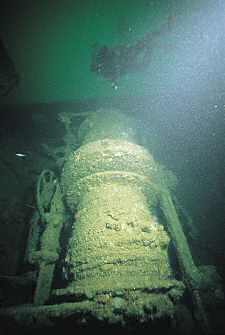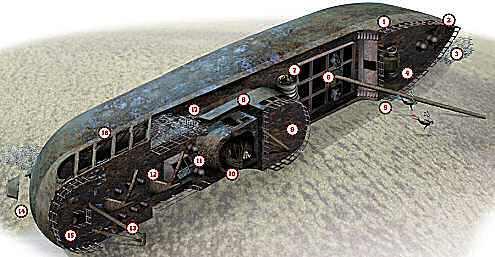Scapa Flow is renowned the world over for its warship wrecks. So why go there to dive a fishing-boat? Because, says JOHN LIDDIARD, it’s there and it makes a fine dive. Illustration by MAX ELLIS
Divers usually make the pilgrimage to Scapa Flow to dive the wrecks of the German fleet from World War One. There are enough battleships and cruisers for a week of first dives, followed by second dives on the shallower cruisers, odd destroyers or blockships.
So who would go all that way to dive a trawler? It’s not even an armed trawler!

Well, the James Barrie is quite a popular wreck, especially with groups that have been to Scapa Flow before and want to dive their favourite warships again, but also expand their horizons a little.
Like all Scapa Flow wrecks, local skippers keep a small buoy tied to the James Barrie. When I last dived it, the buoy was tied off to the railing on the port side of the bow (1).
The wreck lies on its starboard side, across the tide with the bow offshore. At highwater slack, the depth of the port railing is about 33m, with the seabed at 43m.
Following the railing towards the bow, the hull bears a close crop of hydroids and calcifying algae, a few clumps of dead men’s fingers and a fair selection of sea urchins munching their way about.
The port anchor is missing and the hawse-pipe empty (2), though beneath the bow the starboard anchor is still in place (3), held by its chain to the anchor-winch (4).
The foot of the mast is just behind the forecastle, with the mast fallen forward across the starboard railing to the seabed (5).
Just aft of the mast on either side of the wreck are a pair of large oval blocks (6), possibly part of the trawl-gear, though I don’t know enough to identify their purpose. The hold covers have rotted away, leaving a lattice of beams across the opening to the hold.
Entrance is easy, with a fair bit of light penetrating the wreck. In an empty hold, there are no real features to look at, yet in good visibility and nice lighting, swimming along the inside of it can be quite atmospheric.
Back on deck and just aft of the hold, the large trawl-winch (7) spans the deck in front of the wheelhouse (8). The James Barrie was fairly typical of trawlers of the time, with the trawl-gear being laid over the side of the ship from the forward deck.
Visibility in Hoxa Sound is usually better than inside Scapa Flow. In most conditions you can easily see the whole of the wheelhouse standing “above” the deck. It is possible to get inside, but most divers who do so come out covered in the oil that is still slowly leaking from the fuel-tanks.
On the roof of the wheelhouse, the railing is mostly intact. Marine life on the exposed railing includes a few plumose anemones, though there are none of the forests of big anemones found on the wrecks inside Scapa Flow. Perhaps the current here is just too strong for them to hang on.
A tripod structure at the back of the wheelhouse is a small radio and navigation mast (9), the main mast further forward being used exclusively for handling the trawl-gear.
Continuing aft where the funnel used to be, there is just a tangle of debris (10), with the only easy opening to the engine-room being the usual greenhouse-like ventilation-hatches (11). These have swung open to provide a view of the top of the steam engine, though I didn’t venture inside.

The deck further aft forms the roof of the accommodation area, with the bases of ventilators scattered between the boat davits (12). Almost at the stern is a fairly lightweight A-frame mast for the stern light (13).
Venturing over the stern towards the keel, the propeller has been salvaged and the rudder has fallen to the seabed (14), perhaps dislodged to allow access to the prop.
Back on the stern deck, a square railing guards a hatch and ladder (15) down to a sheltered deck that runs right round the stern (16), with cabins inside. As with the hold, there isn’t much to see, but it is a fairly easy bit of almost-wreck penetration with which to have some fun.

At only 666 tons and 54m long, it doesn’t take long to potter round the whole of the wreck, and all that is left is to follow the port railing (17) back to the buoyline (1). With a short slack water, decompression stops might be safer and more comfortable on a delayed SMB than flagpoling on the line with the risk of dragging it under.
The James Barrie is quite a good wreck to use in building up towards longer dives on the deeper battleship wrecks of Scapa Flow, because you don’t need to get into excessive decompression to see it all.
It’s a bit strange that most groups leave it until later in the week, when in many ways it would be better scheduled earlier in a trip as a deeper warm-up dive.
GHOST SHIP
Though all her 21 crew had left her in two rafts when she was badly holed and firmly pinned on to the rocks of a reef in the Pentland Skerries, the British steam trawler James Barrie freed herself two days later and floated off, crewless, into the Pentland Firth, heading for the Orkneys.
The 666-ton James Barrie had been on her way to the Icelandic fishing grounds when she left her home port of Hull on 26 March, 1969, writes Kendall McDonald. At 8.05 the next evening, she ran onto the Louther Rocks. Her skipper, James Brocklesby, said later that they had seen the rocks but were too late to avoid them.
He added that the ship was badly holed on her port bow, taking in water, and that they were stuck fast.
At 6 am, the wind freshened so much that they decided to abandon her. They got away from the rocks by using two of their rafts and were picked up by the Wick lifeboat, which was standing by with the Kirkwall lifeboat and some other fishing vessels.
The James Barrie stayed on the rocks for two days until a high tide freed her, and she drifted towards the Orkneys. The Kirkwall lifeboat, the Grace Paterson, was called out and found her full of water and only just afloat.
The lifeboat took her in tow and headed for Scapa Pier. Moving her put more water into her and, at 12.24 pm on 29 March, she could take no more. She sank off Hoxa Head, near Widewall Bay, South Ronaldsay. Her large bronze propeller was salvaged some years ago.
GETTING THERE: Ferries to the Orkney Islands run from Scrabster, Invergordon and Aberdeen. The longer ferry routes cost more, but have the advantage of shorter road journeys. The Scrabster-to-Stromness ferry is accustomed to divers and has a system for carrying dive-gear for foot passengers, so you can easily leave your car on the mainland. Coaches from Inverness to Scrabster are scheduled to fit in with the ferry schedule. It is also possible to fly to Kirkwall.
DIVING AND AIR: Most diving in Scapa Flow is from large hardboats, many offering liveaboard “floating bunk-room” accommodation. Boats are generally based in Stromness, but might tie up overnight at other harbours. Air is provided by on-board compressors. Nitrox can be mixed onboard most boats for an extra charge. Air, weights and cylinders are usually included in the price, so travelling light and using the boat’s equipment is always an option. Jean Elaine, skipper Andy Cuthbertson, Scapa Flow Charters.
ACCOMMODATION: Sleep on the boat, or stay ashore in a local hotel or B&B. There is a campsite in Stromness, though camping in the Orkney climate is not recommended. Orkney tourist board.
TIDES: Slack water is critical and occurs just one hour before high water in nearby Widewall Bay.
HOW TO FIND IT: The James Barrie lies 400m off Hoxa Head on the South Ronaldsay side of Hoxa Sound. GPS co-ordinates are 58 48.780N, 003 02.150W (degrees, minutes and decimals). As with most Scapa Flow wrecks, there should be a small buoy attached.
LAUNCHING: If you want to ferry your own boat across, there are a number of small slips in Scapa Flow, the closest being at Burray. With a good RIB, John O’Groats is a possible launch-site because the James Barrie is also the closest Scapa Flow wreck to the mainland, though be wary of sea conditions in the Pentland Firth.
QUALIFICATIONS: Experienced sport divers who are capable of doing some decompression. Nitrox can be an advantage to get the most out of this wreck.
FURTHER INFORMATION: Admiralty Chart 35, Scapa Flow & Approaches. Admiralty Chart 2162, Pentland Firth & Approaches. Ordnance Survey Map 6, Orkney & Mainland. OS Map 7 Orkney & Southern Isles. Dive Scapa Flow by Rod Macdonald.
PROS: A nice intact trawler. Visibility in Hoxa Sound is usually better than inside Scapa Flow.
CONS: You go all this way to dive the German Fleet, then dive a trawler?
Thanks to David Carter, Andy Cuthbertson, Tony Jay, Victoria Jay, Jez Kent, Stuart Malcolm, Ben Wade, Matt Wood, and many members of Tunbridge Wells BSAC.
Appeared in Diver, August 2003

